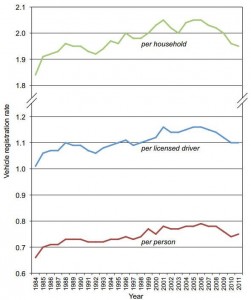The number of cars, vans, SUVs and light trucks on the road in the United States peaked in 2008 at 236.4 million, dipping as low as 230 million in the aftermath of the recession. That number will likely be surpassed as the population continues to grow, says Michael Sivak, in “Has Motorization in the U.S. Peaked?“, a report published by the University of Michigan Transportation Research Institute. But the growth in the number of cars is likely to be far slower in the future.
Other key measures — growth in the number of vehicles per household, per licensed driver and per person — all peaked before the recession, suggesting that something other than macro-economic forces are at work. “The recent maxima in these rates have better chances of being long-term peaks,” Sivak writes.
What’s going on? Sivak points to the increase in telecommuting, from 3.3% of all workers to 4.3% between 2000 and 2010, as well as an increase in the use of public transportation, from 4.7% of workers to 5.0% over a similar period of time. Also, licensed drivers are waiting until they are older before buying a car. Meanwhile, Baby Boomers are retiring in large numbers. Retirees, who no longer drive to work, have less need to own multiple cars.
Bacon’s bottom line: National trends will play out differently around the country, depending on regional variations in the population growth rate. Thus, rural areas that are leaking population probably will see a marked decline in the number of cars on the road, while fast-growth metro areas will continue to experience rising traffic volumes — though less than commonly assumed as recently as the mid-2000s.
— JAB



